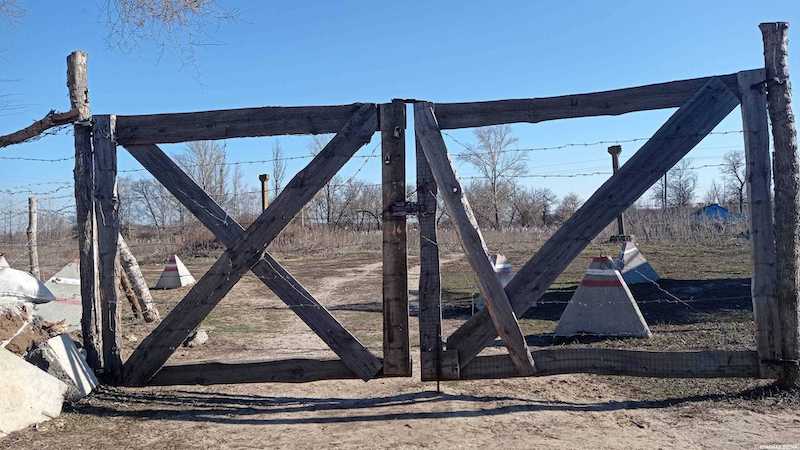With the beginning of the special operation in Ukraine, Vyacheslav Yakovenko, a journalist and militiaman, participant in the defense of Donbass, and native of Lisichansk, went to the Lugansk and Donetsk People’s Republics and worked as a correspondent in the liberated territories all this time
Strelkov’s flight in 2014. Fighting in Lisichansk
I would like to begin with the surrender, I would even say the sale of Slavyansk by Strelkov (Girkin) in 2014. [Strelkov-Girkin was one of the major leaders of DPR militia in summer 2014, who used his authority to withdraw troops and to surrender half of the DPR’s territory to the Ukrainian military without a fight – translator’s note] I shall begin to discuss this event and the subsequent surrender of Lisichansk, as well as the flight of Mozgovoy [was one of the major leaders of LPR militia in summer 2014 – translator’s note] to Alchevsk and Strelkov, respectively, to Donetsk.
During that period I was in Lisichansk and commanded the Vostok-13 unit (Lugansk Region – the thirteenth region of Ukraine). I had about 50 men under my command, and when Mozgovoy decided to flee Lisichansk, my unit and some of the guys who belonged to other units began to defend the city. All in all, there were about 30 of us in Lisichansk.
The city was surrendered after Girkin fled Slavyansk. He exposed a section of the frontline. If you look at the map, it’s Yampol, Seversk and Slavyansk. The road to Lisichansk was open, and it became possible to surround the city.
As Strelkov himself said, Lisichansk was surrendered by Mozgovoy at his request. He asked Mozgovoy to leave the city. Although how can one ask for such a thing in 2014, if it is the militia? It was especially strange since just a few days before, Mozgovoy had declared that he would stand to the end and defend Lisichansk.
Strelkov left Slavyansk on July 4, and since July 19 there has been disorder at Mozgovoy’s base. Вattalion commander Avgust Kostin appointed by Mozgovoy and Mozgovoy himself were missing, and there was no command. Accordingly, the units stationed there did not understand what was going on.
On July 20, at night, the commanders of all the units stationed in the Rubezhnoye-Severodonetsk-Lisichansk agglomeration gathered in the building of the former nightclub “Kosmos” in Lisichansk. After much discussion it was decided to create a single coordinating headquarters, and a consensus was reached that the city of Lisichansk had be defended.
At the time of our general gathering, Aleksey [Mozgovoy] turned up in the city, but part of his combat unit managed to flee to Alchevsk, and other people from this unit joined us. The most tragic thing that happened on July 19 was that near the village of Spornoye, being cut off from Lisichansk, without proper weapons, although Mozgovoy had them, the whole 6th and 7th platoons of Mozgovoy heroically died.
In the morning, the guys from the checkpoint in the southern part of the city began to report that both the Cossacks and Mozgovoy were leaving and moving toward Pervomaysk.
I personally saw Aleksey Mozgovoy in the bunker, which was located in the Lenin Palace of Culture on Krasnaya Street. I went down to it with my comrade, who died later – in 2015. And I honestly want to say – I have never seen such a frightened man in my life. Huddled in a corner of the bomb shelter, clad in all his armor, he was bleating with fear, which filled the entire space of his shelter. We asked, “Lyosha, what about Lisichansk? Didn’t you promise to defend to the last?!” He looked at us and said, “I have orders.” Later it turned out after our personal meeting with Girkin that before he fled the city, Mozgovoy met with Girkin in Donetsk, and Girkin asked him to leave Lisichansk.
On July 21, 2014, at four in the morning, Mozgovoy fled from Lisichansk to Alchevsk and was already giving a morning interview on Channel One Russia so that Ukraine would hear that the militia had completely withdrawn from the city. Although Mozgovoy knew that we stayed in the city.
The Ukrainian army entered Lisichansk in a parade column and did not expect there would be resistance. We met them with dignity, and for three days we held the defense in a circle, but what can 30 people do? On the night of July 24-25, we left the city, exhausted.
The fact that the Ukrainian army’s offensive began on July 19 was not a coincidence. The Ukrainian troops began their offensive at the moment when the most combat-ready group of militia left their positions. But the number of people that were in Lisichansk with the weapons we had would have allowed us to hold out even under encirclement for a month – until August, when a new wave of militia would have come to liberate the city. It would have come! Later I was able to meet with Zakharchenko, and he told me that he had repeatedly sent probe passages to Lisichansk for further assistance to us. It is worth noting that Lisichansk is at a dominant altitude, the city could easily hold out for a month, allowing Ukrainians to enter “in portions” into the city and to destroy them, as we did with 30 men. Tanks and personnel carriers are powerless in the city, it is simply burnt out. This is how we, in particular, unknowingly eliminated on the first day of the storming of Lisichansk the posthumous Major General of the National Guard of Ukraine Radiyevsky, to whom a monument in Severodonetsk was arrected. This monument is already demolished.
The misunderstanding of the political situation brought us to a dead end. Doubtful processes began to take place: Strelkov seemed to be with us, seemed to be with Russia, seemed to be our defense, but his further actions directly indicated a gradual surrender of the entire Donbass. Later, after reading the book Strelkov and Others published by the Essence of Time movement, I decided to join this movement because it was the only organization that stood up against the traitor. During that period of time we repeatedly said that Strelkov and Mozgovoy were traitors, but one could easily be deprived of his life for making such statements.
But the most tragic thing about this whole dark subject is that when he fled from Lisichansk, Mozgovoy left a notebook at the place where he was stationed. This notebook contained the data of residents who had enlisted in his militia. But for some reason, he did not take them into his ranks. After the Kiev regime occupied the city of Lisichansk and the entire agglomeration, raids and persecution of people, torture and reprisals began, and some people simply went missing.
A childhood friend of mine was also persecuted and detained. He survived, although he was tortured very badly by SBU [Security Service of Ukraine] officers who were trying to extract information. Now Lisichansk has been liberated, and I will definitely find him and find out more details about all the atrocities.
Sensations and reality
When the special operation began, I quit my job in Russia, packed up What little I had and went to Donbass, specifically to Lugansk, to cover the events in the liberated territories. And it is a very complex situation there.
Both Channel One Russia and all the Russian federal channels that have their crews in the region are chasing something sensational, they are most interested in human grief, destruction, war, and shooting. And the genesis of everything that is happening and has been happening in the occupied territories is not covered by video and photo reports.
Here are children’s drawings. One can see a drawing of a fighter holding a severed head among them.
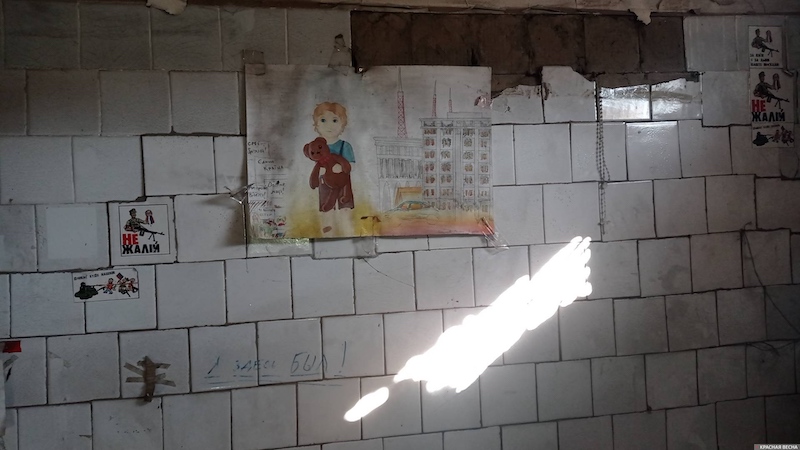
Vyacheslav Yakovenko
One of the high-profile reports aired was about a concentration camp in Polovinkino near Starobelsk, where the Aidar battalion (organization banned in Russia) was stationed and where people were held. This picture hung in one of the rooms where the fighters were stationed. We see the inscription “Have no mercy,” a severed head with a DPR flag in the mouth. Every unit of Ukrainian Nazis has such children’s drawings, a huge number of them.
All such drawings have a backstory.
In 2014, a member of Aidar battalion (organization banned in Russia) posted a video on Twitter in which the head of a militiaman was mercilessly severed and a flag was put in his mouth. This is not a fake, although the Ukrainian side said that it was staged.
There was a board with photos in a school in Novotoshkovskoye. Among all the “prominent” people, there was a photo of the notorious, familiar to all of us ideologist of Ukrainian Nazism Dmitry Dontsov. Children are very strongly indoctrinated with Bandera ideology.

Vyacheslav Yakovenko
There are a number of organizations that take children to Western Ukraine and make them familiar with Galician culture and the Uniate Church. There are entire programs for taking children to Western Ukraine in order to destroy their Russian identity and introduce them to the Bandera ideology.
There is another topic that escapes the view of the federal media: sects. Visiting Ukrainian nationalist bases, I found, for example, a New Testament published by The Gideons International. I took it from the village of Polovinkino, where there was a concentration camp.
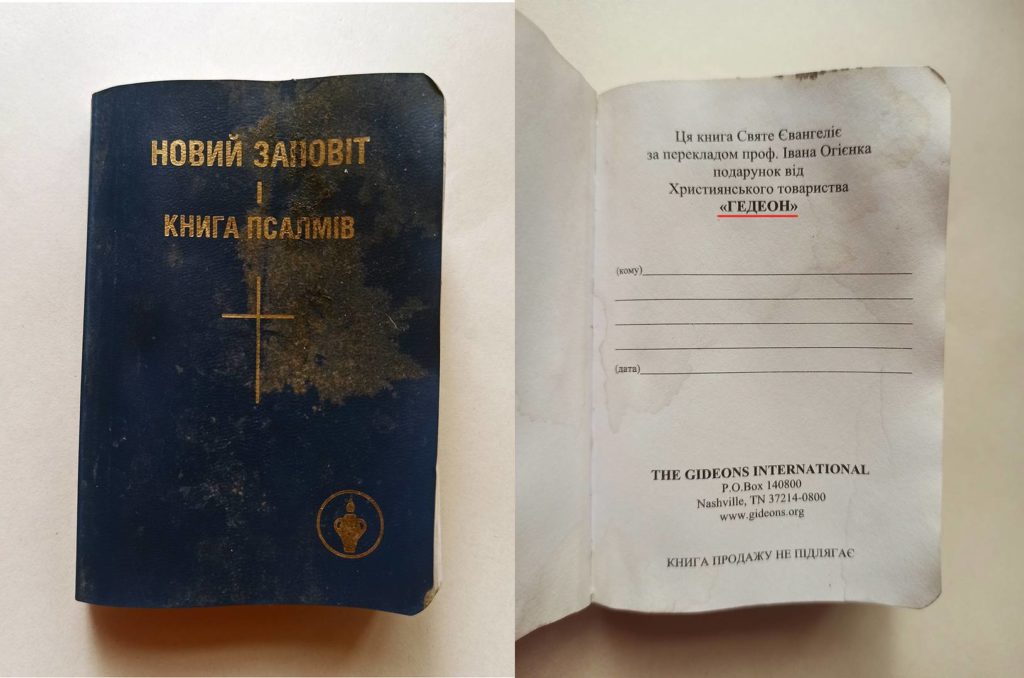
Vyacheslav Yakovenko
I found a whole box of similar books, but in camouflage coloring, near Severodonetsk in one of the foreign mercenary camps in the village of Voronovo. According to local residents, these people looked different and kept apart. The Americans gave them the books. This kind of cooperation between the US and Ukraine should be analyzed in more detail.
The Gideons International was bringing humanitarian aid, luring children away. They conducted various tactical training with them, taught them how to use weapons and ammunition, and brainwashed them spreading Russophobia.
The sect was engaged in this for several years. If you remember, at the very beginning of the special operation there was a scandalous story about how a group of children were taken from Donbass to Lvov, even before the special operation began, “on vacation,” and then not returned to their parents. I think that after a large-scale scandal, these children have been returned.
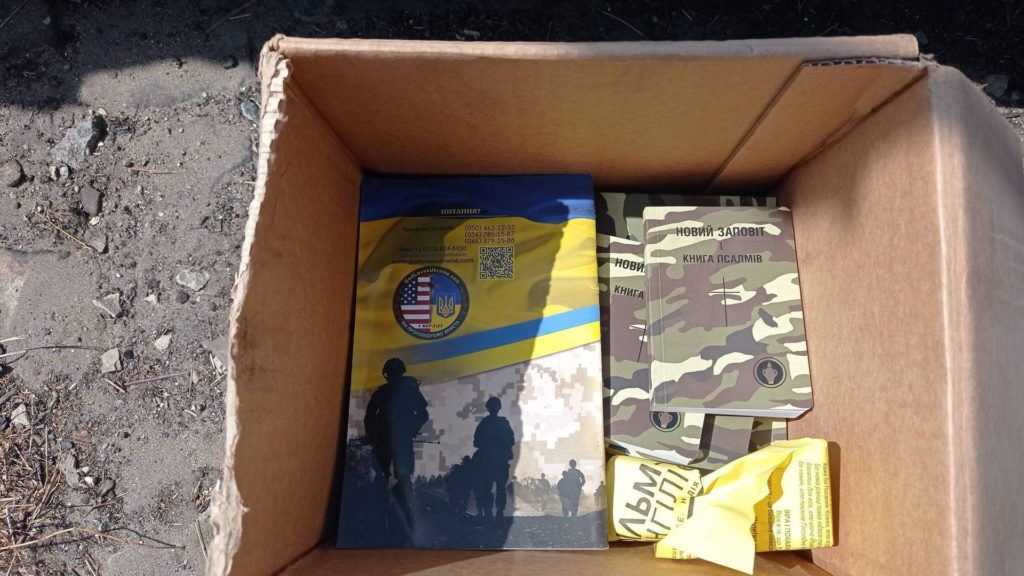
Vyacheslav Yakovenko
The Gideons International operates freely on Russian territory, with representatives of the sect visiting military units.
The Nazi symbols also escape the Russian media.

Vyacheslav Yakovenko
Here is the rune “Othala.” This symbol was worn as an armband by members of the SS Race and Settlement Main Office, which was responsible for the racial purity of the Germans. This symbol is still used to this day by all kinds of neo-fascist organizations around the world.
And this is the battle leaflet of one of the Ukrainian volunteer organizations. One of the symbols of a Ukrainian women’s organization recruiting women into volunteer battalions is seen on it. The leaflet was distributed inside the organization in printed form. It is also published on the website. The same issue differs in content. Some articles are repeated, but the texts of jokes published in the leaflets are different. The leaflets are full of Russophobic statements and anti-Russian propaganda. Russians are called Mokshas [originally this term refers to an ethnic group the Finno-Ugric peoples. The Ukrainian fascists use it to say that, in their opinion, Russians are not separate people or nationality]; Russia is called Muscovy.

Vyacheslav Yakovenko
I found the same symbol in the fortified area of the town of Rubezhnoye, at the chemical plant Zarya, where explosives were produced. The federal media doesn’t notice it.
In the same village of Polovinkino, where there was a concentration camp, one can find an “SS” sign and a swastika. Nazi symbols were found in Severodonetsk airport, where there was a training base, probably for foreign mercenaries. I also came across a plate carrier with two zig runes and other items that directly pointed to the fascist ideology of those to whom they belonged.
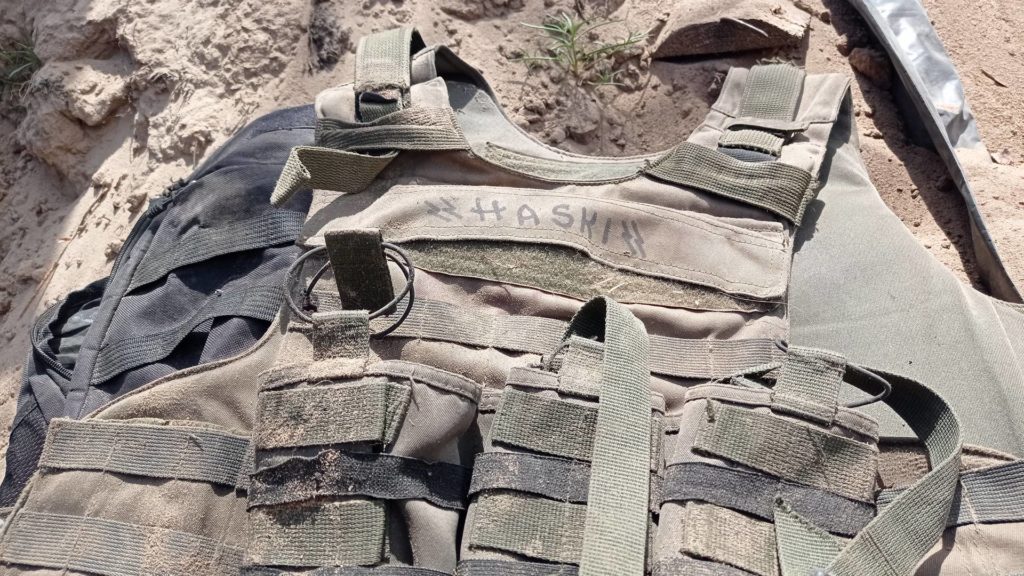
Vyacheslav Yakovenko
At the bases where the Ukrainian armed units were stationed, we found that foreign mercenaries were among the mobilized reservists who had been forcibly enlisted on various pretexts. We found foreign packs and ammunition. At the airport in Severodonetsk I found an OSCE sticker and Oshchadbank card. Mercenaries obviously used it to withdraw their salaries. I also found containers for transporting foreign weapons and ammunition. There we also photographed a large quantity of ammunition, including blank cartridges for NATO weapons, from which we could immediately guess that we were at a former training base of foreign mercenaries.
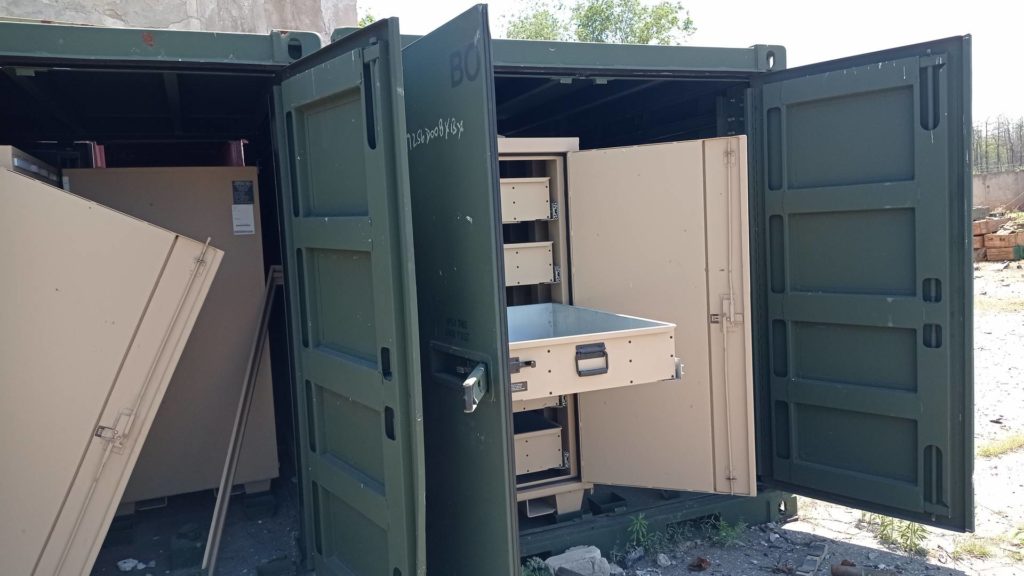
Vyacheslav Yakovenko
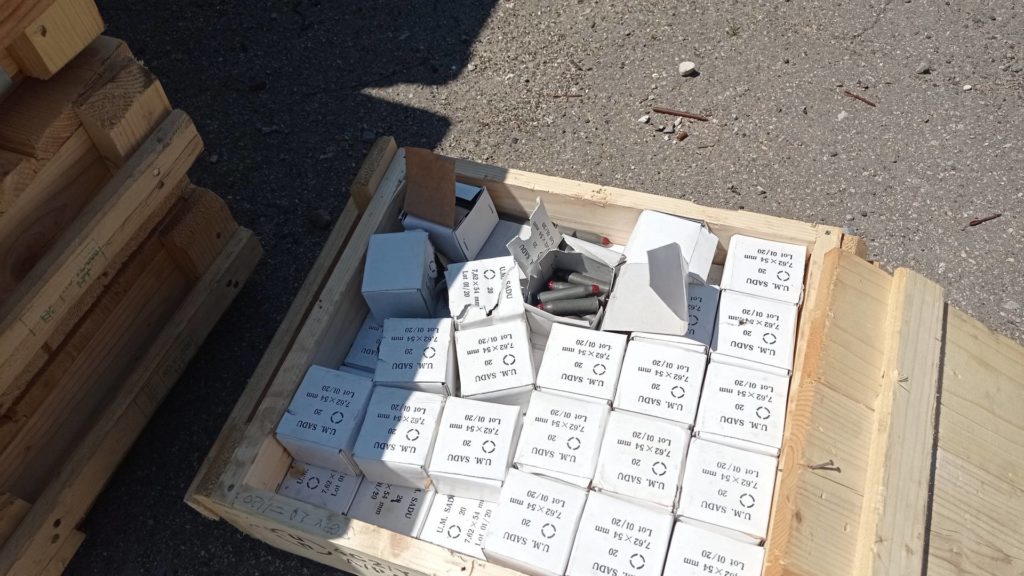
Vyacheslav Yakovenko
I found one-day rations produced in Poland and a Ukrainian uniform with the name and surname of either Polish or Lithuanian origin. In one bunker there was a bomb shelter, and there were found a lot of rations, Polish medicines and uniforms with the Polish flag. In Novotoshkovka, Polish armor plate was found, which is supplied to Ukrainian nationalists from abroad.
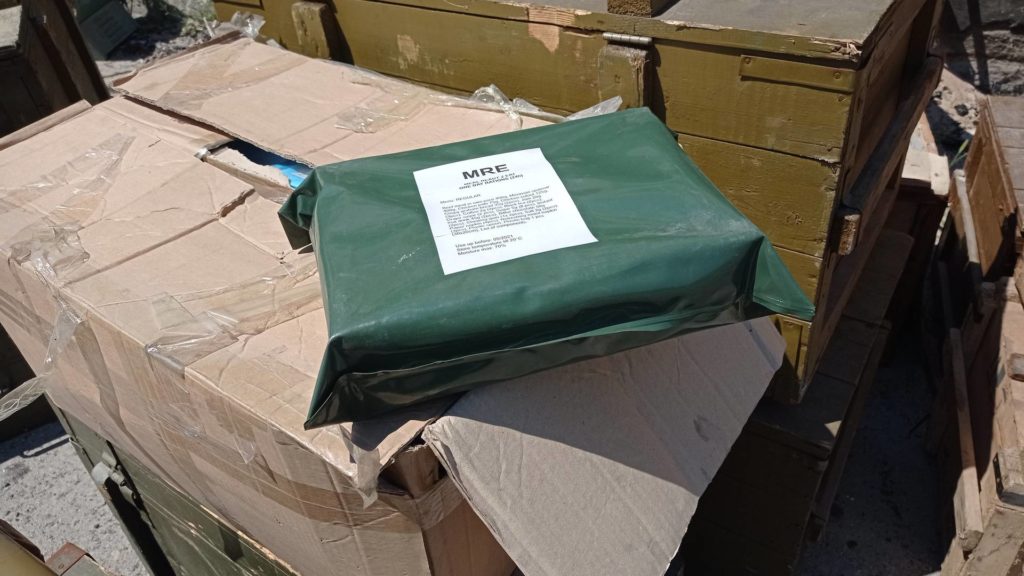
Vyacheslav Yakovenko
Thus, there is multiple evidence that Ukraine is being supplied with NATO and other foreign weapons.

Vyacheslav Yakovenko
Another interesting find is a catalog of weapons in English found in one of the offices of the Security Service of Ukraine (SBU). A colorful catalog of NATO and Russian weapons that are available in Latvia. It has a link to the seller’s site, and although it is no longer open at the moment, using the page archive you can get to that site and see that it belongs to a private organization. That is the USA and all of Europe use such private organizations among others to sell weapons.
The presence of USAID and UNICEF in all the administrative and school institutions in the liberated territories is noticeable. All logos, signs, and brochures bear the logo of these foreign “benefactors”. They do help in some way, but with the aim of changing people’s social consciousness.
It is precisely such seemingly insignificant, but in fact quite serious, things that escape the attention of the federal mass media. It gives the impression that the federal media either does not understand what is going on and who they are waging war against or that this is simply unprofessionalism.
People do not understand what they are at war with.
When I visit administrations in the Lugansk People’s Republic (I don’t know about the Donetsk People’s Republic, but most likely the situation there is similar), I find that no intellectual ideological work is conducted there. The only book worthy of attention and wide distribution in Lugansk and Donetsk People’s Republics and other liberated territories, such as Kherson and other regions is Ukrainism: Who constructed it and why. It is a multi-authored monograph written by the members of Aleksandrovskoye commune of the Essence of Time movement.
People do not understand what they are at war with and what the genesis of this is. It is very regrettable to admit for 30 years we have been driven into ignorance. We don’t even know our own history. When I joined Essence of Time, I began to study the history of my region – Donbass. I didn’t know the feat of the Bolsheviks, or what were the historical precondition for the uprising in Donbass in 2014. After all, it rebelled not only against the Banderites, but also for the people’s power. People power is a Bolshevik, red idea.
And there is not enough political work in the army. Our fighters don’t understand what they are fighting for. Sometimes at the front line I tell the guys the genesis of what we are fighting against – the whole history of “Ukrainism,” from the Cyril and Methodius Brotherhood to the Galician Massacre committed by Russyns in the early 20th century, and why the headdress of the Ukrainian nationalists were called Mazepinka.
One must admit that the enemy is doing strong intellectual work, producing all sorts of materials. I held in my hands, for example, a book dated 2018, sort of a handbook on jurisprudence, but it is written on it that it is about “Justice in Eastern Ukraine under conditions of armed aggression of the Russian Federation.”
Another example is the book In the Ring of Fire: Defense of Lugansk Airport. It was published in 2016. They are writing history right now. They have a lot of various literature, from the standard Ukrainian history written according to their vision, to all sorts of booklets on how to behave under conditions of “aggression.” There is nothing like that in Lugansk, Donetsk or Russia.
Tragedy in a nursing home
At the very beginning of the special operation my classmate contacted me. She saw that I had come to Donbass and started covering the events in Lugansk and the Lugansk People’s Republic. She asked me to find her father, who was in a nursing home in Kremennaya. That town was under the control of Ukrainian Nazis at the time. She had lost contact with him. I promised to help her and started looking into it. I found out that when the fighting started, the administration of the nursing home left the facility and was evacuated. The staff was told to either stay or to be evacuated, while the wards: the deaf, the blind, the generally unable to walk, the bedridden people were left there. Eventually, I came across a nurse who had witnessed the tragedy.
The nursing home is located in a remote place, in the woods. There were to be no intensive hostilities there. When the joint forces of Russia and the LPR approached the nursing home, they came under fire. Therefore, the joint forces were forced to retaliate. A fight errupted and eventually, when the building caught fire, those who could walk began to come out of it. The soldiers were in shock. They heroically, under a hail of bullets, began to rescue the elderly. There were heavy casualties among our personnel.
One elderly man in a wheelchair somehow miraculously got out of the nursing home, dropped behind the evacuated group, and made his way for two days through the forests (our forests are pine trees and there is sand everywhere) in his wheelchair, and was miraculously found by locals from a nearby village.
Fifty-seven people were burned alive in the nursing home. The nurse told me the most horrifying things. First, when the joint forces were still far away, the nursing home came under mortar fire. I emphasize that our people were not even close. After the shelling, artillery observers from the Ukrainian army came to the nursing home (you could tell by their appearance, they were unkempt), and then, sometime later, completely different people arrived, in different uniforms and with excellent ammunition. They drove the residents of the boarding house, who could walk, into the corridor, and set up firing positions near those who were lying in their beds and fired from the windows.
The head of the pro-Ukrainian administration of Lugansk oblast Sergey Gayday makes cynical statements and tries to speculate on this grief. But in the end, it was the armed units serving the Kiev regime that provoked the return fire of the allied forces while using elderly people as human shields.
The territories of Donbass that have now been liberated have long been very carefully and variously prepared by the Ukrainian side for what is now happening there.
“Evacuation” conducted by the Banderites
Take, for example, the way people were evacuated from Lisichansk. It was a “noble operation to evacuate civilians to western Ukraine against the backdrop of the offensive of the damned joint forces.” They were evacuated under tremendous pressure and placed in scattered isolated settlements which men were not allowed to leave. What was left was the small part of the city’s population that proved to be the most resilient and stubborn.
We all know that no one was allowed to go to the LPR and the territories under the control of Russia. The people were deprived of this opportunity. They were taken specifically to the territory that is under the control of the Kiev regime.

Vyacheslav Yakovenko (organization banned in Russia)
In Lisichansk, Ukrainian militants opened fire on the residential area and brought in foreign reporters after a while. Then an evacuation group came that exerted pressure on people living in this area. And after that, the residents were driven out of there. The locals themselves in the territories liberated by the joint troops of Russia and the LPR told this.
In some cases, when, for example, private houses were suitable for the tactical purposes of the Ukrainian army, people were driven out at gunpoint, put into evacuation cars and taken to Dnepropetrovsk, Ivanovo-Frankovsk, Ternopol, and Lvov. In Lvov, there were many abandoned houses without access to public utilities. The evacuated people were placed there. The abandoned houses suddenly had owners who received compensation from Europe. As a result, citizens evacuated in such a way from Lisichansk live in inhumane conditions. No aid reaches them, they have no food and clothes.
Investigation of war crimes
Regarding the investigation of war crimes. At the moment there are still hostilities on the outskirts of the LPR, however, the Military Prosecutor General’s Office is already working on the territory of the republic, and as soon as the opportunity arises, it begins to investigate crimes.
I saw the aftermath of the punitive operation in Sirotino, a village not far from Severodonetsk, where I reported from, talking to local servicemen. One serviceman told me, “We were here looking for fuel at one of the gas stations and when we opened the tanks we found two bodies of civilians with their hands tied. They were killed and thrown into the fuel tanks. The Right Sector (organization banned in Russia) was based there. The Nazis simply eliminated civilians who in any way opposed them or simply had a different point of view on what was happening, starting in 2014.”
There are many similar cases. Take, for example, the testimonies of the residents of Lisichansk, which have yet to be investigated. This city is generally considered a city of “separatists,” as the Banderites themselves said. In 2015, the special unit in which I served managed to obtain a Ukrainian database of people wanted by the Kiev regime, This database is called “Blokpost” and is similar to “Mirotvorets,” except it works without the Internet and contains all the data on the “separatists.” So, there are about 800 wanted people in Slavyansk. These are those who joined the militia or were loyal to Russia. In Lisichansk there are more than 1.5 thousand such people. That is why it was the only city that greeted the joint troops with flowers and a red flag.
This is a translation of the article written Vyacheslav Yakovenko and published in The Essence of Time newspaper, issue 491.

